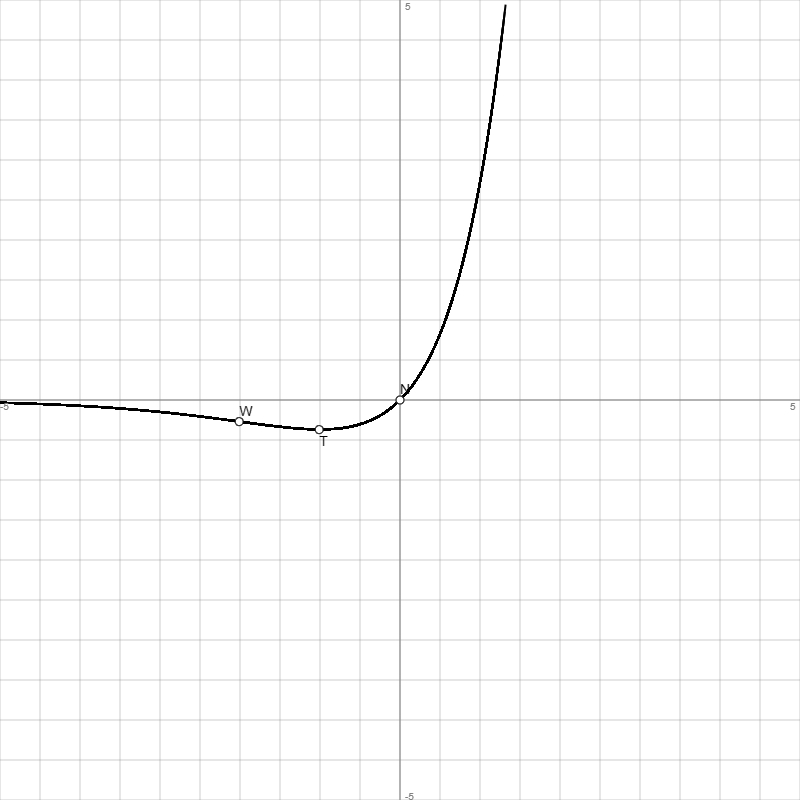
www.michael-buhlmann.de
Funktion: f(x) = e-x/2/x, Df = R, Wf = R\(-1.3591; 0], reelle Funktion, x -> -∞: f(x) -> -∞, x -> +∞: f(x) -> 0 = y als Grenzkurve ->
| Wertetabelle: | |||||
| x | f(x) | f'(x) | f''(x) | f'''(x) | Besondere Kurvenpunkte |
| -6 | -3.3476 | 1.12 | -0.46 | 0.19 | |
| -5.5 | -2.8441 | 0.9 | -0.38 | 0.15 | |
| -5 | -2.4365 | 0.73 | -0.32 | 0.11 | |
| -4.5 | -2.1084 | 0.59 | -0.27 | 0.09 | |
| -4 | -1.8473 | 0.46 | -0.23 | 0.06 | |
| -3.5 | -1.6442 | 0.35 | -0.21 | 0.03 | |
| -3 | -1.4939 | 0.25 | -0.21 | -0.02 | |
| -2.5 | -1.3961 | 0.14 | -0.24 | -0.11 | |
| -2 | -1.3591 | 0 | -0.34 | -0.34 | Hochpunkt H(-2|-1.36) |
| -1.5 | -1.4113 | -0.24 | -0.67 | -1.16 | |
| -1 | -1.6487 | -0.82 | -2.06 | -6 | |
| -0.5 | -2.5681 | -3.85 | -16.05 | -96.76 | |
| 0 | Infinity | Infinity | Infinity | Infinity | Senkrechte Asymptote/Pol x = 0 mit Vorzeichenwechsel: x -> 0-: f(x) -> -∞, x -> 0+: f(x) -> +∞ |
| 0.5 | 1.5576 | -3.89 | 15.97 | -95.23 | |
| 1 | 0.6065 | -0.91 | 1.97 | -5.97 | |
| 1.5 | 0.3149 | -0.37 | 0.57 | -1.17 | |
| 2 | 0.1839 | -0.18 | 0.23 | -0.37 | |
| 2.5 | 0.1146 | -0.1 | 0.11 | -0.15 | |
| 3 | 0.0744 | -0.06 | 0.06 | -0.07 | |
| 3.5 | 0.0496 | -0.04 | 0.03 | -0.04 | |
| 4 | 0.0338 | -0.03 | 0.02 | -0.02 | |
| 4.5 | 0.0234 | -0.02 | 0.01 | -0.01 | |
| 5 | 0.0164 | -0.01 | 0.01 | -0.01 | |
| 5.5 | 0.0116 | -0.01 | 0.01 | 0 | |
| 6 | 0.0083 | -0.01 | 0 | 0 | |
| Graph: | |||||
 | |||||
Abkürzungen: Df = (maximaler) Definitionsbereich, f(x) = Funktion, f'(x) = 1. Ableitung, f''(x) = 2. Ableitung, f'''(x) = 3. Ableitung, H = Hochpunkt, L = Lücke, N = Nullstelle, P = Polstelle, R = reelle Zahlen, S = Sprungstelle, T = Tiefpunkt, W = Wendepunkt, WS = Sattelpunkt, Wf = Wertebereich, {.} = ein-/mehrelementige Menge, [.; .] = abgeschlossenes Intervall, (.; .) = offenes Intervall, [.; .), (.; .] = halboffenes Intervall, ∞ = unendlich.
Bearbeiter: Michael Buhlmann